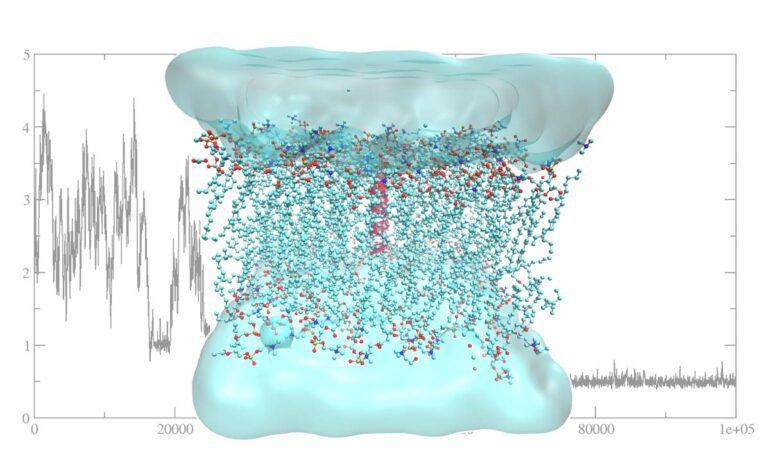TL;DR:
- Harvard researchers employ a large, pretrained Allegro model to predict biomolecular dynamics on a large scale.
- The Allegro model achieves SOTA precision, modeling systems with up to 44 million atoms.
- Machine learning interatomic potentials (MLIPs) have been revolutionized, overcoming past limitations.
- Active learning techniques automate the construction of training sets, enhancing the training process.
- Allegro’s scalability surpasses traditional designs, enabling fast simulations of massive material systems.
- The research opens up new avenues in biochemistry and drug discovery.
Main AI News:
The fields of computational biology, chemistry, and materials engineering are revolutionized as Harvard researchers unleash the power of deep learning to predict large-scale biomolecular dynamics. By leveraging a large, pretrained Allegro model, the team has successfully scaled their research across various systems, propelling scientific exploration to unprecedented heights.
At the heart of these disciplines lies the crucial task of foreseeing the evolution of matter on an atomic scale. While quantum mechanics governs the intricate vibrations, migration, and bond dissociation of atoms and electrons, the observable physical and chemical processes often span considerably larger lengths and time scales. To bridge this gap, innovation is required in both highly parallelizable architectures with access to exascale processors and rapid, highly accurate computational methods capable of capturing quantum interactions.
The current computer approaches, unfortunately, fall short of probing the structural complexity of realistic physical and chemical systems. Moreover, their limited duration of observable evolution hinders comprehensive atomistic simulations. However, recent advancements in machine learning interatomic potentials (MLIPs) have opened up new possibilities.
Over the past two decades, researchers have delved into MLIPs, harnessing the power of learned energies and forces from high-precision reference data. These potentials scale linearly with the number of atoms, presenting a promising avenue for computational analysis. Early attempts involved Gaussian Processes and simple neural networks coupled with manually crafted descriptors. However, the predictive accuracy of these early MLIPs proved inadequate, as they struggled to generalize to data structures not present in their training data. Consequently, simulations became fragile and lacked versatility.
In an exciting breakthrough, the Harvard lab has unveiled its groundbreaking research, showcasing the tremendous potential of the Allegro model in modeling biomolecular systems. Astonishingly, the model exhibits state-of-the-art (SOTA) precision even when dealing with systems containing up to 44 million atoms. The team accomplished this feat by employing a large, pretrained Allegro model, tailor-made for systems ranging from DHFR with 23,000 atoms to Factor IX with 91,000 atoms, cellulose with 400,000 atoms, the HIV capsid with a staggering 44,000,000 atoms, and other systems surpassing 100,000 atoms. With 8 million weights, this formidable Allegro model achieves a forced error of a mere 26 meV/A, surpassing previous benchmarks and delivering hybrid functional accuracy on the remarkable SPICE dataset.
The true potential of this model lies in its ability to enable fast exascale simulations of expansive material systems that were previously unimaginable. By learning from vast sets of inorganic materials and organic molecules at an unprecedented data scale, the Allegro model ushers in a new era of scientific exploration. With its massive size, boasting 8 million weights, this model provides an unrivaled platform for unraveling the mysteries of biomolecular dynamics.
To further enhance the training process, the researchers have embraced active learning, automating the construction of training sets. By efficiently quantifying the uncertainty of deep equivariant model predictions of forces and energy, the team has overcome the accuracy bottleneck. Equivariant models, known for their accuracy, are now bolstered by Gaussian mixture models seamlessly integrated into the Allegro framework. This breakthrough empowers large-scale uncertainty-aware simulations, eliminating the need for ensembles and streamlining the entire process.
Allegro’s unique scalability sets it apart from traditional message-passing and transformer-based designs. The research team has demonstrated remarkable speeds, surpassing 100 steps/second across various large systems. Furthermore, these impressive results scale up to simulations encompassing over 100 million atoms. Even in the challenging scenario of modeling the HIV capsid with its 44 million atoms, the simulations remain stable for nanoseconds without any significant issues. The production phase has seen minimal obstacles, reinforcing Allegro’s reliability and performance.
Conclusion:
The breakthrough achieved by Harvard researchers in utilizing the Allegro model for biomolecular dynamics signifies a transformative milestone for the market. The ability to accurately model systems with millions of atoms and capture complex interactions through deep learning opens up vast opportunities in computational biology, chemistry, and materials engineering. The scalability and precision of the Allegro model provide scientists and researchers with unprecedented tools for understanding and predicting the behavior of biomolecular systems. This breakthrough will fuel advancements in drug discovery, biochemistry, and materials science, driving innovation and shaping the future of the market.

